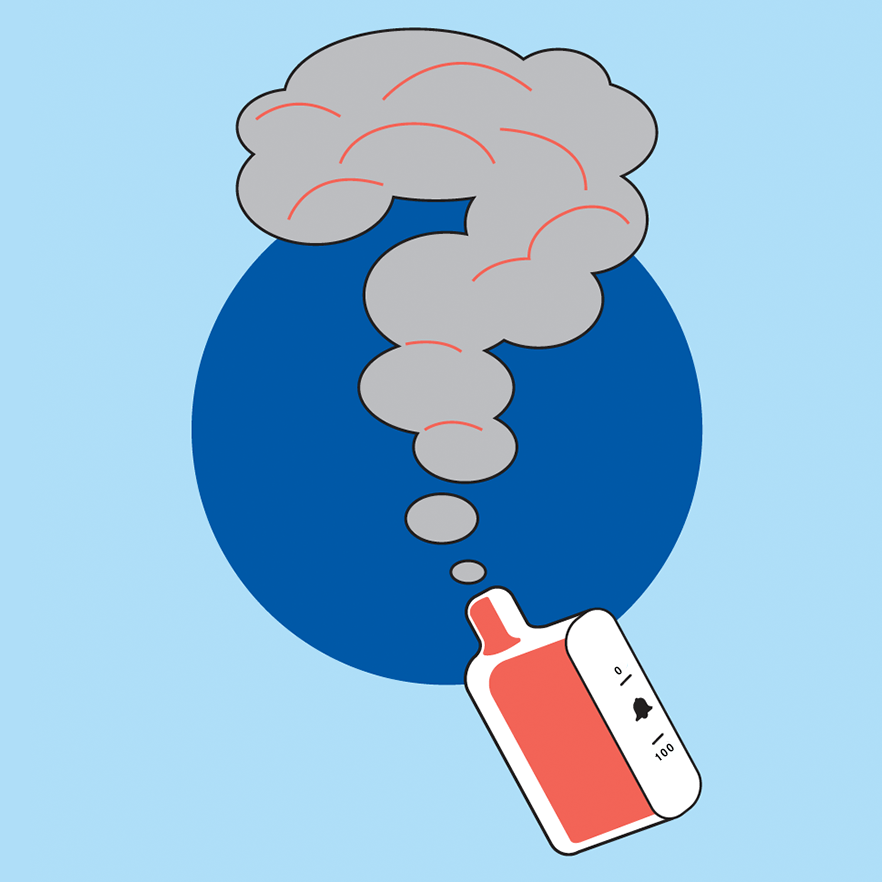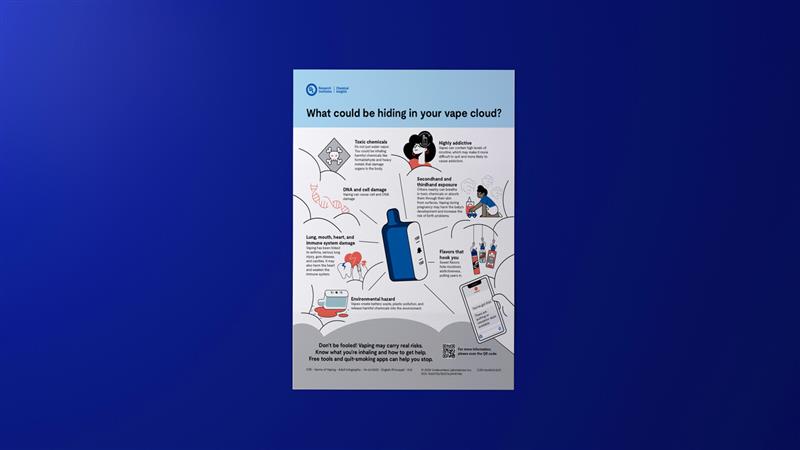
Understanding the Hidden Health Risks of Vaping
E-cigarettes and vaping: what science says about health and safety implications
As e-cigarette and vape electronic nicotine delivery systems (ENDS), use continues to rise among youth and young adults, new research is shedding light on the potential health risks of these products.

What is in vapes?
Vape clouds aren’t harmless steam — they’re aerosols packed with chemicals.
When you vape, you could be inhaling substances like nicotine, solvents, and flavorings. When the device’s metal coil is heated, it can release heavy metals like nickel, cadmium, and lead. Vape clouds also contain ultrafine particles, volatile organic compounds (VOCs) and harmful chemicals like formaldehyde, all of which can irritate your lungs and other organs.
Hidden vaping Risk #1: Lung Health
How vaping affects your lung health
When puffing the substances found in vapes and e-cigarettes, users are inhaling aerosols, which can contain a mixture of nicotine, solvents, flavorings, harmful chemicals, and heavy metals. These aerosols can contain particles that can enter deep into the lungs, potentially causing damage to lung cells, which can lead to asthma, lung disease, scarring in the lungs, and lung cancer.

Hidden vaping Risk #2: Heart Health
How vaping affects your heart health
Once in the lungs, chemicals from vaping can enter the bloodstream. Data indicates daily use of vapes and e-cigarettes is associated with increased odds of experiencing a heart attack. Continued use can potentially damage the body’s cells. Over time, this damage might lead to the development of high blood pressure (hypertension) and increased heart rate. This can, in turn, lead to lasting changes in blood flow.

Hidden vaping Risk #3: Dental Health
How vaping affects your dental health
Researchers linked vaping and e-cigarette use to a wide range of dental health concerns, including gum recession and disease, bleeding gums, and tooth loss. Continued vape use has also been shown to increase the microbial (bacteria) adhesion within the mouth, which can lead to bad breath, “vape tongue,” and a variety of oral health conditions.

Hidden vaping Risk #4: second and thirdhand exposure
The secondhand risks of vaping
Vaping impacts more people than just the person doing it. When someone vapes (firsthand exposure), they are exposed to harmful chemicals and metals that can impact their health. Secondhand vape exposure happens when vape emissions are exhaled into the air. These emissions can be unknowingly inhaled by bystanders and can have adverse health effects, similar to secondhand smoking. Secondhand vaping emissions can accumulate on clothes, hair, dust, and furniture, leading to thirdhand vaping exposure.

By the numbers
Vaping and e-cigarette use is not without consequences
Facts and misconceptions about vaping
From misconceptions about vape emissions being just water vapor to the belief that vaping is safe during pregnancy, widespread assumptions are not necessarily supported by current scientific evidence. Explore below to discover what risks might be hiding behind each misconception.
Vape emissions are not just water vapor
Vape devices operate by heating e-liquid to high temperatures, causing the production of vape emissions. E-cigarette emissions include vapors (i.e., the gaseous phase in the emission), but most of the cloud produced (and that which is visible) is an aerosol. Aerosols encompass both naturally occurring substances like dust, fog, and smoke, as well as man-made substances like particulate air pollutants, sprays, and emissions from vape devices. E-liquids contain an array of chemicals. These chemicals are often not disclosed on the product label, even if ingredients are listed (which they may not be). A typical e-liquid contains propylene glycol and vegetable glycerin as the main ingredients, as well as nicotine, flavoring agents, and a variety of other potentially harmful substances.
Vaping is not safe during pregnancy or breastfeeding
Vaping during pregnancy can cause adverse effects for the mother and the developing fetus. Some studies have found that vaping during pregnancy increases the risk of small-for-gestational-age birth compared to babies of women who do not vape. Heavy metals have been linked to an increased risk of abnormalities during fetal development. Additionally, exposure to a main metabolite of nicotine, cotinine, has been linked to behavioral and psychological impacts on children.
Secondhand exposure to vaping when pregnant can also cause issues with unborn children, including the potential transfer of glycerol and heavy metals into cord blood.
Those who are pregnant should discuss the impacts of vaping with their healthcare provider.
Secondhand vaping may harm those around you
The idea that vaping does not harm those nearby is a misconception. The exhaled vape emissions linger in the air and can be unknowingly inhaled by bystanders in secondhand vaping, a process akin to secondhand smoking. Secondhand vaping emissions can accumulate on clothes, hair, dust, and furniture, leading to thirdhand vaping exposure for bystanders of all ages, such as a toddler who touches vaping residue on furniture and ingests it due to hand-to-mouth behavior. These exposures are exacerbated in indoor spaces, especially if there is minimal ventilation. One study reported that increased secondhand vaping emissions are associated with a higher risk of wheezing, bronchitis-like symptoms, and asthma attacks in youth. Studies also suggest that thirdhand vaping impairs lung function and health. Non-users sharing a home with vape users had significant levels of certain associated chemicals in their saliva and urine compared to non-users in control homes, which indicates that individuals can be exposed to secondhand and thirdhand vaping emissions by living with ENDS users.
Anyone interested in the impacts of vaping on bystanders and indoor environments should consider these factors:
- Exhaled vape emissions linger in the air and impact the health of those around them.
- Vaping impacts indoor air quality and bystanders in the same space through secondhand exposure.
- Secondhand vaping emissions can accumulate on clothes, hair, dust, and furniture, leading to thirdhand vaping exposure by bystanders of all ages.
Vaping waste pollutes the environment
Single-use and rechargeable vape devices are increasingly popular. Federal guidelines prohibit manufacturers and users from throwing away this waste in household trash and mandate a disposal management system, which includes discarding these items in a household hazardous waste collection site. However, these standards are often disregarded, with a lack of collection sites in place, and users may not even know that throwing a vape device in the trash is prohibited. According to the Centers for Disease Control and Prevention (CDC), the number of vaping devices sold annually in the U.S., if lined up, would stretch over 7,000 miles—enough to span the continental U.S. twice. This scenario has resulted in a large and increasing amount of toxic and plastic waste from disposable vapes and pods going to landfills. Waste from each vape device contains unused e-liquid (which may contain nicotine), a battery (usually lithium), a metal heating coil, and a non-biodegradable plastic case. Lead and mercury from these devices can leach into soil and sand. Beyond chemical leaching, the non-biodegradable case and other parts, such as the nicotine pod, will end up in oceans and threaten ocean life; ocean conservancy and beach cleaning volunteers have reported a significant increase in vaping device waste, even as cigarette butt waste has declined. With the increased use and acceptability, vape waste could become the number one waste and litter item in the U.S., persisting in nature without decomposing.
Anyone interested in vaping waste or its environmental effects should consider these factors:
- Vape users should never dispose of device parts in the regular trash.
- Vape device parts can contaminate the environment.
- Leftover nicotine in a vape device can contaminate the environment.
- Vape device parts should be disposed of at proper recycling centers.
Source: UL 200D Guidance Document: Science Education and Research on Vaping and Interventions for Community Engagement (SERVICE).
This document was produced by a task force co-chaired by Christa Wright, Ph.D., Research Director within Chemical Insights and Jonathan Shannahan Ph.D.,
of Purdue University, under a grant from the National Institute of Dental and Craniofacial Research (project number 1R56DE031814-01) .
Read More
Stay informed
Sign Up for Insights
Stay informed with the latest emerging environmental health and safety research. Sign up for Chemical Insights Research Institute’s updates to receive cutting-edge insights, expert analyses, and actionable knowledge straight to your inbox.
By submitting this form, I am opting in to receive communications from UL Research Institutes (ULRI) containing news and updates about its work and initiatives. I understand that I can manage my preferences at any time and agree to ULRI’s online policies.
Partnerships
Everyone benefits when world-class institutions work together to take on big challenges. Join us.
Grants
We’re funding scientific research to make the world safer, healthier, and more sustainable. Learn about funding opportunities.
Careers
Work to make the world a safer place. Start a rewarding career at UL Research Institutes with other socially minded colleagues focused on innovation, collaboration, and ethics.






